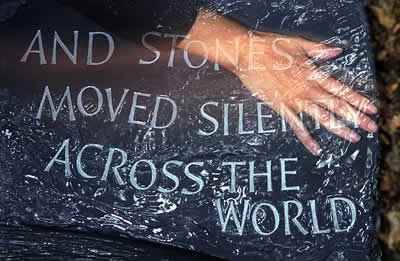Erratic Stones

The migration habits of stone – image via
And stones moved silently across the world
hurled into an empty ship’s weightless hold
folded into a glacier’s freezing mound
quick-pocketed by tourists and children
with an eye for things shiny and round.
This is a poem by Alyson Hallett, from The Stone Library – and an extract below, where she is explaining how her project The Migration Habits of Stone came about – I’ve copied her words because she writes about it so beautifully.
Half-way up the slopes of Cader Idris I came across a large boulder that looked completely out of place. As I stood there wondering why it looked so different a man happened to pass by. He also happened to be a geologist. He told me the stone was an erratic that had broken away from its motherbed centuries ago, lodged in ice and then set off on a very long, slow journey. The carriage of ice carved canyons and gorges as it moved along and when the sun next shone strongly enough the ice melted and the erratic stone was deposited in a new and unfamiliar landscape.
I was fascinated by this. Gripped. Bewitched. I felt as if a door had opened onto a different way of seeing the world. Instead of being eternally fixed in place, stones were suddenly fellow travellers and movement was an essential part of their natures. I thought not only of erratics but also of the stones we place on graves, the pebbles that we bring home after a day at the beach. Was it possible, I wondered, for that pebble to want to be picked up and taken away as much as I wanted to pick it up and take it with me?
Lovely thoughts. I’ve felt myself, of stones I call ‘foreign’, that some reconciling is needed before I carve them. How naturally and easily I can put a chisel to a lump of local sandstone, but have stood before an imported stone, formed oceans away, with difficulty and hesitation. There’s a knowing of its difference that goes deep.
I had a piece of Opal Stone from Zimbabwe in my workshop for many years before carving it. When I finally put it on my workbench it had layer upon layer of dust from its long period of abandonment. On cutting into it, I found an explosion of colour, texture and spirit and was lost in and journeyed through far away lands, of new sounds and smells – of new sensations of tool on stone. (This is the piece it made – Bee Eater).
I’m certain that this stone wanted to take me away as much as I wanted to make it feel at home here.

2 Comments
I was on a river trip once and we were taking a layover day, hanging out in the river, and one of our group was idly picking up the small stones on the bottom and throwing them back upstream. I had this silly thought in my head that he had disturbed the stones’ migration, put off the eventual end to their journey downstream, causing them to cover ground they had already traversed and they were none too happy about it.
What a lovely thought Ellen, and thanks for contributing your story to this idea – I too am now concerned about those stones. I have placed carved fish stones into the river and sometimes wonder where they are now!